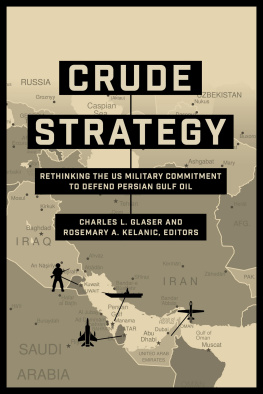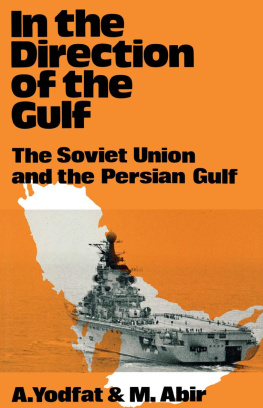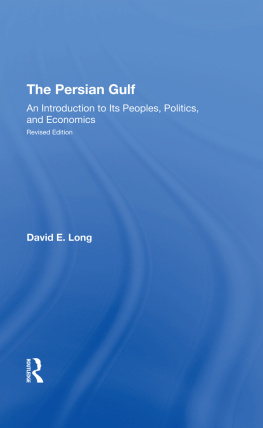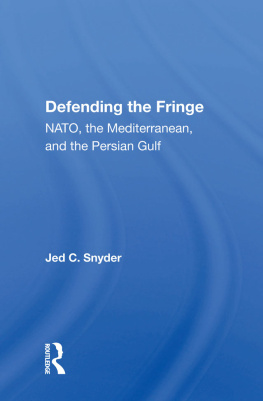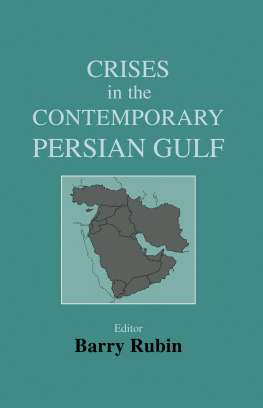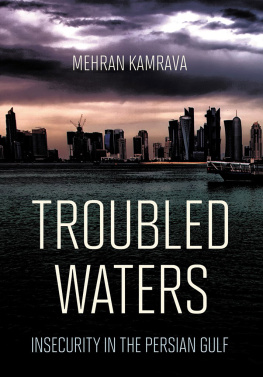Crude Strategy
Crude Strategy
Rethinking the US Military Commitment to Defend Persian Gulf Oil
Charles L. Glaser and
Rosemary A. Kelanic, Editors
Georgetown University Press | Washington, DC
2016 Georgetown University Press. All rights reserved. No part of this book may be reproduced or utilized in any form or by any means, electronic or mechanical, including photocopying and recording, or by any information storage and retrieval system, without permission in writing from the publisher.
Library of Congress Cataloging-in-Publication Data
Names: Glaser, Charles L. (Charles Louis), 1954 editor. | Kelanic, Rosemary A., editor
Title: Crude strategy : rethinking the US military commitment to defend Persian Gulf oil / Charles L. Glaser and Rosemary A. Kelanic, editors.
Description: Washington, DC : Georgetown University Press, 2016. | Includes bibliographical references and index.
Identifiers: LCCN 2015040461 | ISBN 9781626163348 (hc : alk. paper) | ISBN 9781626163355 (pb : alk. paper) | ISBN 9781626163362 (eb)
Subjects: LCSH: Persian Gulf RegionStrategic aspects. | Petroleum industry and tradePolitical aspectsPersian Gulf Region. | United StatesMilitary relationsPersian Gulf Region. | Persian Gulf RegionMilitary relationsUnited States. | United StatesForeign relationsPersian Gulf Region. | Persian Gulf RegionForeign relationsUnited States.
Classification: LCC UA832 .C78 2016 | DDC 355/.0330536dc23
LC record available at http://lccn.loc.gov/2015040461
This book is printed on acid-free paper meeting the requirements of the American National Standard for Permanence in Paper for Printed Library Materials.
17 16 9 8 7 6 5 4 3 2 First printing
Printed in the United States of America
Cover design by Faceout Studio, Charles Brock. Cover image by Thinkstock.
Contents
CHARLES L. GLASER AND ROSEMARY A. KELANIC
SALIM YAQUB
DANIEL BYMAN
KENNETH R. VINCENT
THOMAS W. LIPPMAN
JOSHUA ROVNER
EUGENE GHOLZ
JOHN S. DUFFIELD
CHARLES L. GLASER AND ROSEMARY A. KELANIC
CAITLIN TALMADGE
Illustrations
Figures
Map
Tables
Acknowledgments
This book is truly a collective endeavor, and many people helped along the way toward its completion. First and foremost, we would like to thank the authors of this volume, not just for contributing excellent chapters, but also for offering helpful feedback on all sections of the manuscript that greatly improved the final product.
For detailed comments on early drafts that were presented at our authors workshop, we would like to thank Steve Fetter, Greg Gause, Marc Lynch, Michael OHanlon, and Rob Weiner, as well as participants in the Energy Security Working Group at the Institute for Security and Conflict Studies in the Elliott School of International Affairs at George Washington University. Dan Jacobs provided excellent research assistance on issues that cut across chapters, and Catherine Silvey offered invaluable administrative support.
We are deeply grateful to an anonymous donor to the Elliott School, whose generous support made this volume possible. We also thank Don Jacobs and his team at Georgetown University Press for their expert editorial guidance, as well as the anonymous reviewers for their insightful input. Last but not least, we thank our families for their unwavering support.
Introduction
CHARLES L. GLASER AND ROSEMARY A. KELANIC
America has long defined the free flow of Persian Gulf oil as a key component of its grand strategy. Since the late 1970s US military force has increasingly become the instrument for achieving this end. The 1979 Iranian Revolution spurred plans to bolster American military power in the region, and the mission took on new urgency when the Soviet Union invaded Afghanistan by the end of the year. In the wake of Moscows surprising move, President Jimmy Carter warned in January 1980 that the flow of Persian Gulf oil was a vital US interest and that Washington would use any means necessary, including military force, to protect it. The statement became known as the Carter Doctrine, and in one form or another, it has underpinned US policy ever since. The Rapid Deployment Joint Task Force created in March 1980 enabled the United States to quickly project power into the region. Three years later the United States created Central Command as a unified, multiservice command responsible for South Asia and the Middle East. To support its military requirements in the Persian Gulf, the United States built up significant sealift and airlift capabilities, prepositioned matriel in the region, negotiated access to regional facilities, and improved its major military base at Diego Garcia in the Indian Ocean. The United States fought the Gulf War of 1991 to ensure that Iraqs invasion of Kuwait was not the first step toward Saddam Hussein dominating the regions oil supplies. US capabilities deployed in the region increased further following that war. The Iraq War of 2003, although not directly related to US oil interests, would likely not have occurred but for the long-standing oil-driven involvement of the United States in the region.
The American objective of protecting Persian Gulf oil has generated little controversy among scholars and policymakers since the Gulf became a focus of US military deployments in 1980. The Persian Gulf has kept its central role in US grand strategy primarily because it accounts for a large fraction of global oil exports and proven reserves. This unquestioned focus on protecting Persian Gulf oil may seem unsurprising given the widely appreciated importance of oil to the American economy. The United States consumes roughly 19 million barrels of petroleum daily, accounting for nearly 20 percent of global consumption. Petroleum is the single largest source of energy in the United States, accounting for 36 percent of all US primary energy consumption, and it plays a special role in transportation, which relies on oil for 92 percent of its fuel. More broadly oil plays a critical role in the health of the global economy, which in turn influences the US economy.
Nevertheless, the US military commitment to the Gulf should be revisited. Since the United States established its commitment, quite dramatic changes have occurred in the regional balance of power, the nature of threats to US security, and global energy trendsall of which bear directly on US interests. This opens up the possibility that the United States should significantly revise its policy toward the Persian Gulf both in terms of how it defines its strategic interests in the region and in the means it uses to pursue them.
Motivated by these observations, this book analyzes two questions. First, and most basic, should the United States continue to rely on military capabilities to preserve the flow of Persian Gulf oil? To answer this question, we examine the key rationales driving current US policies, lay out the assumptions and conditions upon which they depend, and assess how strong the case for American involvement really is. If the threats to Persian Gulf oil have diminished, or if oil disruptions themselves have become less dangerous to the United States, an American security commitment to the region may no longer make sense. Yet even if the old assumptions hold and the United States should remain strategically engaged in the Gulf, questions remain about whether the current US military posture in the Gulf is the right one.
This observation naturally segues to our second question:

